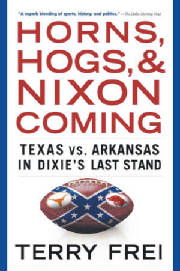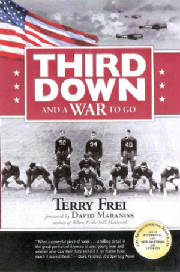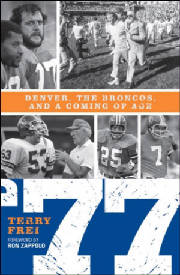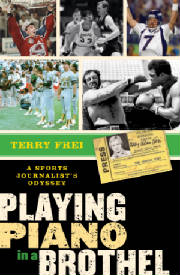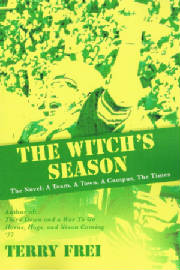January 14, 2023
In 2016, the NFL's $1-billion settlement of concussion claims
with retired players seemed only the latest of the hits to the game's participatory future.
When the Bills' Damar Hamlin suffered cardiac arrest in the
recent game against the Bengals and from all indications beat the odds to survive, that tightened and brightened the spotlight
on football's dangers. This is the whispered secret, too: It's actually surprising that life-threatening or otherwise horrific
trauma isn't more common.
We
knew football wasn't going away, but the warning signs about the risks -- at all levels -- have been piling up. I've
written about the issue many times over the years, especially noting the toll of Chronic Traumatic Encephalopathy and in many cases the posthumous confirmation of its presence in former players after their brains were donated for
study.
That included several figures in my books, most
notably former University of Texas defensive tackle Greg Ploetz, whose wife, Deb, sued the NCAA and reached a settlement just before the potentially
landmark case was about to go to trial. (To read more about the Ploetz saga, including his battle with dementia late in his
life, go here and scroll down to the section of links on Ploetz.)
I did several stories on former Broncos running back Rob Lytle, who died in 2010.
Plus, I wrote an award-winning newspaper story on the physical problems many members of the 1977 Broncos ('77: Denver, the Broncos, and a Coming of Age) were having in post-retirement life, plus other followup pieces on that
team. In the media, we've also followed the stories of CTE's confirmed presence and effects, most of them tragic to varying degrees. I'd be willing to bet that if it becomes possible to conclusively determine if a retired, but still-living, NFL player has
CTE, a majority would.
The point is, I've seen and written about the tolls of the game from many angles, across many years. I've
even got the scars that are evidence of two ACL surgeries. The only quibble I have with the recent coverage of Hamlin's amazing
survival -- with the help of those who quickly came to his aid -- is that many seemed to overlook or underplay scary and terrible
incidents in the past, including instances of paralysis (among them, Darryl Stingley and Mike Utley). While the risks might
be most striking at the NFL level because of the cumulative tolls from mouth-dropping impacts among the best in the sport,
it's far from danger-free at, say, the junior-high or high school levels. I'm not going to do hours of research and crunch
numbers and provide a flood of anecdotal examples. That's not necessary to make the point: It's a perilous sport. Period.
That's a rambling preamble, but I fully admit that
as evidence piled up I thought football would be an endangered species by now, first and perhaps foremost because of liability
issues at youth and high school levels. Conceded, all other sports -- whether hockey, soccer, basketball and even baseball
-- have their injury perils, including concussions. But football is at the top of the list, involving immediate tolls and
inevitable eventual physical deterioration. If you are able to take roll at Bronco Alumni weekends and assess the physical
damages, you wince. You feel their pains. You really do.
Then you come to the key questions, those more tied to football than any others:
In 2023 -- or beyond -- would you let
your kid play football?
In
2023 -- or beyond -- and you were a kid, would you want to play football?
This part is both good and bad:
Increased athletic specialization among the young cuts into the football numbers. This might seem contradictory, but count
me among those who applaud the benefits of playing multiple sports, whether football is one of them or not. I also think it's
a step forward if young athletes cease feeling some sort of obligation to play football because that's what good athletes
are supposed to do, thanks to peer pressure.
I was raised in Eugene, where my father was on the Oregon football staff for 17 seasons -- the final five
as head coach. I attended South Eugene High until the middle of my junior year, when we moved to Denver and I became a Wheat
Ridge Farmer. In the 2021 season, albeit with COVID-19 winding down, South Eugene, virtually adjacent to the U of O campus
and with many kids of faculty members enrolled, didn't even field a football team. Not enough would-be players turned out
for the Axe varsity. I wondered if it was a harbinger of schools either dropping the sport or of multiple schools forming
combined teams, as often happens in hockey. Plus, soccer and track and field are popular at South, drawing off potential football
players. (Football returned at South, at a lower classification, in 2022.)
But the landscape continues to change. Another of my concerns is that the mania tied to NIL, the
transfer portal and "x"-star prospects picking out one of the hats in front of time to indicate their college choice
as a path to the riches of the NFL will add to the unrealistic expectations that long have been common. That could lead to
young men ignoring the perils of the game and assuming more than ever before that they're invulnerable.
Yes, play football. But because you want to, not because of the perception that your
buddies or your parents want you to. Not because you're on the fast-track to the college game or the NFL. (You likely aren't.
And don't let anyone lay that crap on you that if you want it bad enough, you can achieve it. Life isn't fair.) Parents should
grill their sons on those points. Plus, of course, feel confident that coaches and others involved know what the hell
they're doing. And if you don't like it, you're NOT a "quitter" if you give it up -- whether in the middle of a
season or just before fall practice starts.


